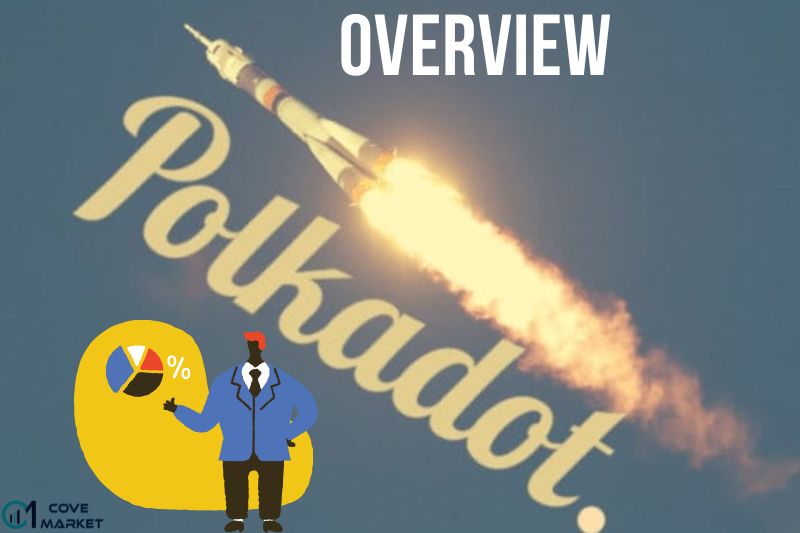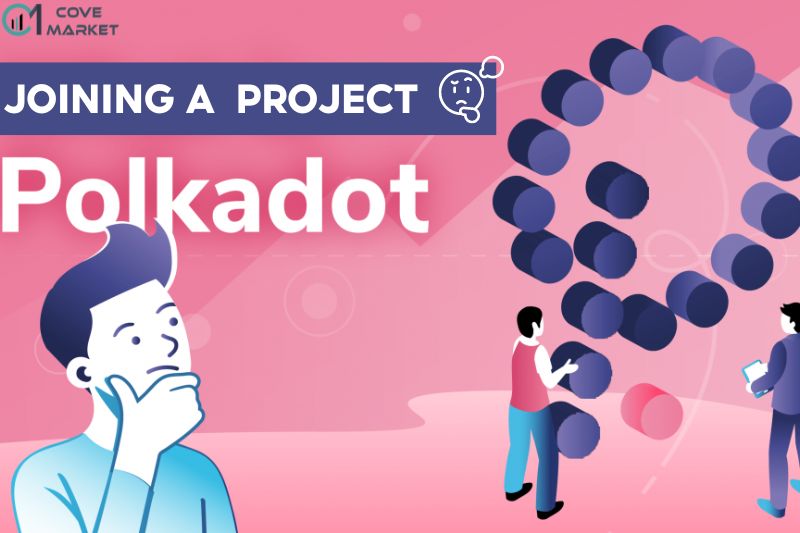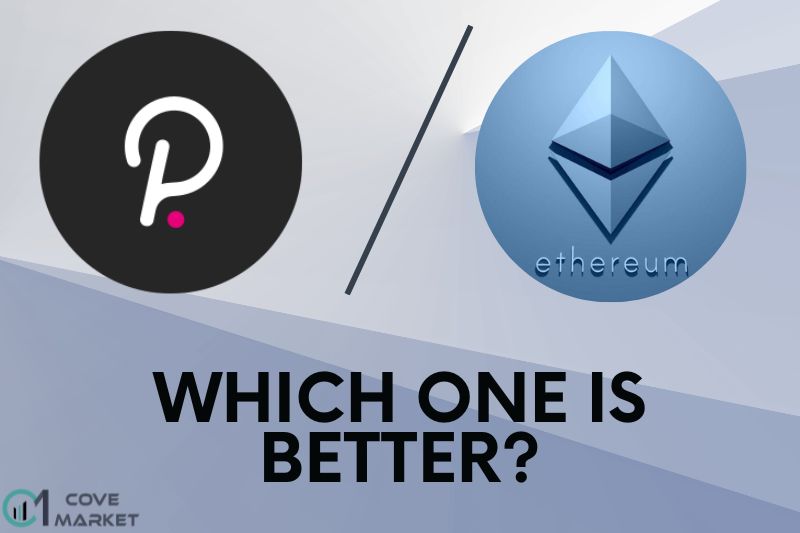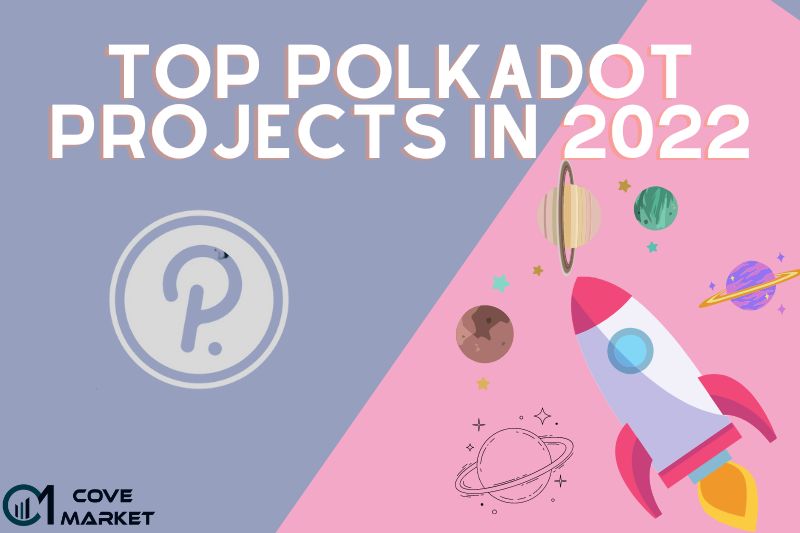POT is undoubtedly familiar to the majority of users. What, however, draws hundreds of companies to this protocol, selecting it to power their Fintech and dApps? The infrastructure behind Polkadot is what makes it so popular.
Covemarkets.com have compiled a list of the Top Polkadot projects that it is thought to have such promise to assist users in getting started. Check them out in the list below, and if traders like one or more of them, learn more about them, think about investing in them, or at the very least, keep a watch on them and their growth over the coming months and years.
Overview

What is Polkadot?
Polkadot, one of the most well-funded blockchain companies to come out of the 2017 ICO craze, raised more than $140 million from investors.
Since that time, co-founders Robert Habermeier and Dr. Gavin Woods have been putting a lot of effort into planning the Polkadot launch, which happened in May 2020 and will be finished this year.
In addition, Dr. Gavin Woods co-founded Ethereum and created the Solidity programming language.
What are Polkadot-based Projects?
Polkadot-based projects are those that use the POT network to function. Polkadot is a decentralized network that allows for the interoperability of different blockchains.
This means that Polkadot-based projects can communicate and interact with each other and with other blockchains that are not part of the POT network.
Top Polkadot Projects To Know In 2023: Which Is The Most Prospective?

Covemarkets.com won’t keep traders waiting any longer; without further ado, let’s go to our list of the top Polkadot projects in 2023.
Kusama (KSM)
Kusama (KSM), often known as Polkadot’s “crazy cousin,” describes themselves as such. Canary networks are a sort of network that allows developers to design and test new projects before implementing them on a chain.
Kusama was initially established as a canary network for Polkadot, meaning its primary purpose was to serve Polkadot.
Over time, however, a good number of the projects decided to remain and eventually became Kusama’s native projects, which are unique to this network.
Kusama was able to evolve into an actual network because of this, moving beyond its role as Polkadot’s testnet.
Because the two share comparable technology, all of the benefits POT offers are available on Kusama, in addition to several projects that are exclusive to this chain at this time.
On the other hand, Kusama has been pulling in many projects thanks to its highly scalable and interoperable sharded network.
The appeal of Kusama is that it has a lot of features that it does not, which are there in the experimental phase, which is why investors typically go to Kusama to check out the projects and learn early on which ones to invest in.
Acala (aUSD)
The Acala project has been in the works for quite some time, and its debut was planned for the year 2021. Integrating the DeFi capability into the ecosystem is the primary objective of this project.
Technically speaking, this project operates based on a dual protocol, with one of those protocols being Homa (which ensures stake liquidity), and the other protocol being Honzol (supporting the collateralized stablecoin aUSD for the system).
The network is completely decentralized, and the token holders make all decisions regarding its operation, following a vote process.
Moonbeam (GLMR)
The blockchain community is excited to test and investigate Moonbeam in 2021, and it is another project that they are looking forward to.
Moonbeam claims to combine full Ethereum network compatibility with Polkadot, pushing the bounds of scalability and cross-chain interaction.
This promise is without precedent. It is believed that the solution will make it easier to create decentralized applications (dApps) and provide Ethereum users with many tools they are accustomed to using, in addition to integrating Substrate-based APIs.
Moonbeam will therefore serve as a bridge between two powerful blockchain solutions by combining the solid performance with the user-friendliness of Ethereum.
Moonbeam will do this by integrating the network with the Ethereum blockchain.
Edgeware (EDG)
Edgeware is a “self-improving smart contract blockchain for the POT ecosystem.” The Edgeware on-chain treasury, which is governed by chosen network members, supports the growth of the Edgeware blockchain.
An initial coin offering (ICO) for the Edgeware token (EDG) was conducted in the summer of 2019 using a fair distribution and lockup methodology without an initial pre-mine. Furthermore, the Edgeware blockchain’s genesis block distributed nearly 90% of all EDG tokens.
If accepted, Edgware could end up being the most straightforward method for installing smart contracts on the Polkadot network as Polkadot’s first smart contract parachain.
As a result, Edgware will likely rank among the most popular projects and become an essential part of the ecosystem.
Ternoa (CAPS)
The first blockchain explicitly designed for data transmission via NFT using Polkadot Substrate technology is Ternoa. The project aims to establish itself as the leading decentralized storage network for NFT goods.
With the help of Project, investors can simply construct time capsules with images, videos, or texts on their smartphone. Each time capsule is secured with encryption and decentralized storage on the project blockchain to distribute it to the recipients.
- Quick, trustworthy, and effective Blockchain has been created to mint NFts, offering users a robust and scalable infrastructure.
- Because Ternoa is constructed on a substrate and employs Nominated Proof of Stake (NPoS), NFTs have the least amount of carbon impact feasible.
- Data Security: Blockchain and Trusted Execution Environments (TEEs) are combined in cutting-edge technology to encrypt metadata.
- Develop an ecosystem of open source tools with a distinctive user experience to support the adoption of NFTs in daily life.
Robonomics (XRT)
The POT network’s Robonomics infrastructure project promises to house more than 1 million IoT digital twins with the same level of security and accessibility as cloud platforms managed by IT companies.
Developers of robotics will see that these digital twins are incorporated into ecosystem initiatives, giving automated systems access to resources they had not previously had.
For manufacturing, logistics, and urban living, direct access to fintech solutions without a bank.
Darwinia (RING)
A blockchain network called Darwinia can link to other blockchains via cross-chain, making it interoperable and able to connect to chains like Polkadot, Ethereum, TRON, and other heterogeneous chains.
The “Golden Gate Bridge” of cross-chain ecology, Substrate, serves as the foundation for Darwinia’s decentralized network.
The Darwinia Network can be used to develop various applications, including Defi, cross-chain NFT trading, games, and more.
The Polkadot ecosystem includes Darwinia Network as a partner, and even POT founder Gavin Wood praised Darwinia as a promising initiative.
Darwin’s Network in the Polkadot Ecosystem
PolkaFoundry (PKF)
PolkaFoundry is designed to enable decentralized applications (dApp) to be helpful, accessible, and widely accepted. In the long term, it aims to be a viable decentralized alternative to cloud computing platforms.
Polkafoundary is aiming to build its blockchain on the POT Substrate.
Some dApp developer support services on the PolkaFoundary blockchain:
- Identity Service (PolkaID)
- Document Storage Service (DocuGuard)
- Oracle Service (Decentralized Gate).
These components allow dApp developers on the platform to take full advantage of the decentralized network on Polkafoundary and the data available to facilitate the creation of dApps and easy tracking of users.
Polkastarter (POLS)
Thousands of crypto enthusiasts are choosing to maximize their return on investment (ROI) by investing in potential companies while they are still in their early phases.
This has caused an investment boom in blockchain startups. Polkastarter is a new platform that provides a solution for fundraising by bringing together investors and entrepreneurs looking to acquire capital to finance their respective initiatives in one secure location.
As a result, investors have access to projects at the launch or pre-launch stage, and developers can acquire finance for their blockchain initiatives from various sources within the financial world.
Moonriver (MOVR)
Moonriver is designed to be a parachain on the Kusama network. Its target audience is developers, whose primary function is to provide compatibility with the Ethereum blockchain.
This is accomplished by delivering an EVM (Ethereum Virtual Machine) implementation, enabling developers to leverage the platform and ecosystem more effectively.
Both Moonbeam and Moonriver are based on the same software, although they are deployed on separate blockchains.
Moonriver may easily be used in conjunction with EVM. Because of this, developers will be able to take advantage of Ethereum’s existing infrastructure, such as Chainlink’s Oracle compatibility or Band Protocol.
However, they will be able to do so at a faster speed and with greater convenience, as there will be no need to go through censorship until the deployment on the leading network.
What to Consider When Joining a Polkadot Project?

Before joining a POT project, it is essential to consider the following factors:
- The team: It is essential to research the team behind the project. Look for information about the team’s experience and expertise in the blockchain space.
- The technology: It is also essential to evaluate the project’s technology. Look for information about the project’s roadmap and whether the team has the technical expertise to deliver on their promises.
- The community: A solid and supportive community is essential for the success of any project. Look for information about the project’s community engagement and whether the team is responsive to community feedback.
- The tokenomics: The tokenomics of a project can have a significant impact on its success. Look for information about the project’s token distribution and whether the team has a sound economic model.
- The project’s vision: Finally, aligning with the project’s vision is critical. Make sure investors believe in the project’s long-term goals and are excited about its potential.
Is Polkadot Ecosystem Better than Ethereum?

DOTt’s ecosystem is still in development, so it is difficult to say whether it is better than Ethereum.
However, POT does offer some advantages over Ethereum, including the ability to process transactions faster and more cheaply and to support a more diverse range of applications.
FAQs

What are the transaction fees on Polkadot blockchain?
POT users can conduct transactions at no cost, as the platform does not impose any transaction fees.
Within the Polkadot ecosystem, this type of blockchain transaction charge is the zero-cost blockchain transaction fee.
What is the focus of each Polkadot project?
The focus of each project is to build a secure and scalable blockchain platform that enables interoperability between different blockchains.
Which is the best Polkadot project?
The best project for users may vary depending on their specific needs and preferences. However, some popular POT projects include the Parity Ethereum client, the Substrate blockchain platform, and the JS library.
Where can I learn about upcoming Polkadot projects?
The DOT network is constantly evolving. Cove markets recommend following the POT blog and subscribing to the POT newsletter to learn about upcoming projects.
Conclusion
These are only some fantastic projects that are now accessible for investment on Polkadot, and they appear to have tremendous potential to become very successful in the future. Polkadot’s ecosystem as a whole is enormous.
As can be seen, its ecosystem also features a significant amount of diversity, which means that there are a plethora of possibilities available to investors looking for fresh investment opportunities and something distinct and original with which to diversify their portfolios.

